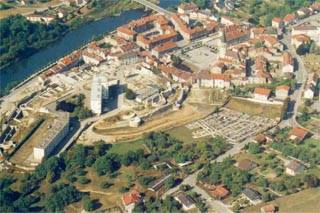Forteresse Médiévale de Châtel sur Moselle

With its strategic position along the Moselle river at the junction of three major Roman roads and at the gateway of the trans-Burgundy highway, Châtel played a major strategic role all along, even in 1940 and 1944 during World War II. It had belonged to the counts of Vaudemont, second house of Lorraine, since 1072, until they pledged allegiance to the counts of Bar about 1200, seeking their protection.
After Alix de Joinville-Vaudémont got married to Thiebaut VII de Neufchatel in 1373, Châtel became a possession of the prominent and wealthy family of the Comté of Burgund, the Neufchatel family, who fitted up Châtel as keystone of a commercial and political area under Burgundian influence.
It became part of Lorraine through an exchange agreement in 1544. The fortress resisted the French invasion during the 30 years War and was besieged no less than nine times between 1634 and 1670. It was completely dismantled in 1671.
Build on a promontory made of limestone just over the Moselle river, the castle was separated from the plateau by dry ditches 63 yards wide. It overlooked the town and the ramparts, flanked at the time by twelve towers and with to gateways. Around the single rectangular tower of the original XIth century castle, other large scale buildings were erected at the beginning of the XIIIth century.
It was furthermore extended and modernized during the XVth century and changed into a much more defensive place to meet the threat of the new artillery. At that time the castel was protected by 21 towers and by two outer walls with a total combined length of about one mile.
A sophisticated network of galleries allowed remarkable communication between the various parts of the castel, the town, and the banks of the river.
Since May 1972, international volunteer camps and government assisted workers craftsmen employees have worked towards the excavation, restoration, and preservation of the site.
Furthermore the "Assiociation du Vieux Châtel", overseeing all the operations, periodically organizes workshops, exhibits, concerts, courses and national heritage classes.
|
Add this place to your selection

|











